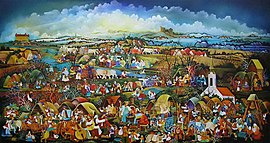|
Kovačica
Kovačica (Serbian Cyrillic: Ковачица, pronounced [koʋǎtʃitsa]; Slovak: Kovačica; Hungarian: Antalfalva; Romanian: Covăcița) is a town and municipality located in the South Banat District of the autonomous province of Vojvodina, Serbia. According to the 2022 census, the town has a population of 5,398, while the municipality has 21,178 inhabitants.[2] It is widely known for its naïve art that the local residents make without any form of art school. GeographyThe town of Kovačica is located 27km from Pančevo and 43km from Belgrade. HistoryThe town was founded in the 18th century, but there are records of small settlements dating from 1458. In the middle of the 18th century, this area was recorded as a wasteland. Settlement was founded in 1750 and was settled (in 1751–1752) by Serb soldiers from Potisje and Pomorišje, after military frontier in these regions was abolished. In 1767, Kovačica was included into German regiment of Banatian Military Frontier. First Slovaks came here from Ečka and Aradac (in 1783) and after them, Slovaks from Arvas, Trenčin and Bekeš county came here as well (in 1801). From the middle of the 19th century, Kovačica is a center of municipality and cultural and social center of Slovaks in Banat.[3] SettlementsKovačica municipality includes the town of Kovačica and the following villages: Demographics
According to the 2022 census results, the municipality of Kovačica has 21,178 inhabitants.[2] Ethnic groups Communities with Slovak majorities are: Kovačica (Slovak: Kovačica) and Padina (Slovak: Padina). Communities with Serb majorities are: Crepaja, Idvor, Putnikovo and Samoš. There is one community with a Hungarian majority: Debeljača (Hungarian: Torontálvásárhely), and one community with a Romanian majority: Uzdin (Romanian: Uzdin). The ethnic composition of the municipality:[2]
EconomyThe following table gives a preview of total number of employed people per their core activity (as of 2017):[5]
Naïve art Kovačica is well known for the tradition of naïve art, originating from local Slovak painters.[6] The Gallery of Naïve Art, founded in 1955, is a major tourist destination in the area. Its most notable representatives are Zuzana Chalupová, also known as Mama Zuzana, Martin Jonáš, Jan Knjazovic, Martin Paluška, Jan Sokol and Jan Venjarski. The gallery organizes various exhibitions and events, such as Kovačički oktobar (Kovačica October), and has a collection of over 800 paintings.[7][8] In December 2024, Kovačica's naïve art was recognized by UNESCO as an Intangible cultural heritage.[9] International relationsTwin towns — Sister citiesKovačica is twinned with: See alsoReferences
External linksWikimedia Commons has media related to Kovačica. |
||||||||||||||||||||||||||||||||||||||||||||||||||||||||||||||||||||||||||||||||||||||||||||||||||||||||||||||||||||||||||||||||||||||||||||||||||||||||||||||||||||











